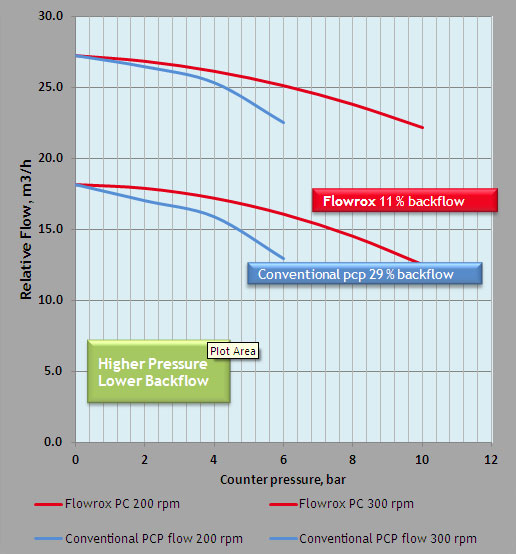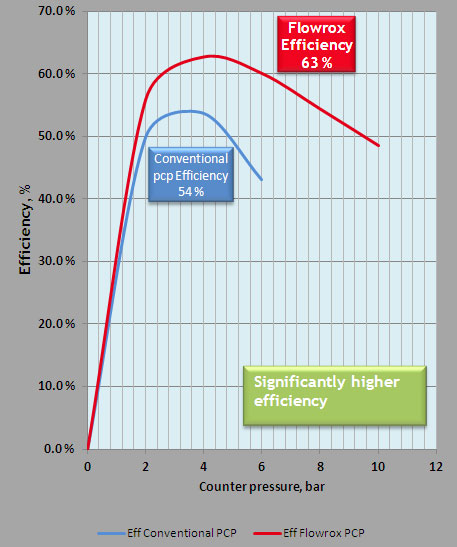Progressive cavity (PC) pumps are commonly referred to in industry as mono-pumps, screw pumps, eccentric screw pumps or worm pumps. All are positive displacement pumps. The inventor of the progressive cavity pump is Rene Moineau. Because of this, they may also be called Mono pumps, Moyno pumps, Mohno pumps or Moineau pumps—all derivatives of Moineau’s name.
Moineau was designing a compressor for early jet engines in 1930 when he determined that this principle could work efficiently for pumping fluids. He teamed with Robert Bienaime of Gevelot Group to found PCM Pompes in 1932 to develop the world’s first known progressive cavity pump.
Pump Components and Operation
The PC pump consists of two major components, a rotor and a stator. The rotor is helix shaped, machined from either stainless steel, hard-coated carbon steel or hard-coated stainless steel. Depending on the pumped fluid, the stator can be composed of nitrile rubber, natural rubber, EPDM or flouroelastomers similar to Viton.
As the rotor turns within the stator, the fluid is driven to the surface within the spaces, or cavities, between the rotor and the stator. Therefore, the PC pump moves the fluid from the suction to the discharge end by continuously shifting spaces (which are the progressing cavities) between the rotor and the stator. Since the rotor and stator have a small interference fit and low rotating speed, the internal shear rates are low. For this reason, the PC pump is recommended for highly viscous and/or shear-sensitive liquids and sludges. Key industries for PC pumps are pulp and paper, wastewater and oil.
New Spiral Technology
In general two types of stators can be used in PC pumps—a standard, round stator and a spiral designed stator. Spiral designs are a relatively new development. Standard, round stators have been used for the past 80 years. Even rotors with 2D and 3D geometry have been around for many years. However, spiral stator technology is a modern advancement with only a fraction of PC pump manufacturers offering this option.
 |
| The spiral stator (left) allows for higher pressure per stage and 2/3-lobe elliptic rotor higher flow rate than the standard, round stator (right). |
Spiral technology often offers higher efficiency and higher pressure and flow capabilities. This technology’s stator has a much thinner rubber lining. Standard round technology has a much thicker layer of rubber inside the stator. The lining of the spiral technology is even all around the stator. With more rubber in the standard stator, the tolerances need to be much lower than that of the stator of a spiral technology—also called even-wall technology—pump. This results in less efficiency and wear in round stator designs.
Traditional, round stators also suffer extreme wear during start-up. For instance, highly abrasive materials will slip or leak backward because of the cold rubber, which has not heated or expanded. This expansion of the thicker rubber in the stator is required to tighten the tolerances to allow more efficient pumping. During this time, the PC pump will suffer more wear or damage. With even-wall technology these extreme tolerances are not required. Therefore, the even-wall technology is more efficient at start up and during normal operation.
Spiral Stator Technology Versus Conventional Round Stator
The spiral stator PC pump uses an even-wall spiral stator technology that allows for a more rigid and tighter pumping unit. With the enhanced compression of rotor and stator friction, spillover and wearing is minimized so the PC pump can be used with the same rotor in higher temperatures. When compared to the conventional stator design, the even-wall pump experiences less interference between the rotor and the stator, which results in a lower starting torque and higher efficiency.
Higher Efficiency & Improved Hydraulic Performance
When comparing the hydraulic performance of an even-wall PC pump to a conventional PC pump, the results are higher pressure, lower back flow and higher efficiency. Figure 1 shows a comparison of the relative flow (gallons per minute) versus the counter pressure (bar) between the even-wall PC pump and the conventional PC pump.
The relative flow rate drops as the pump counter pressure increases. This trend reflects how the pump hydraulic efficiency drops due to counter pressure increase. When comparing the hydraulic efficiencies of both PC pumps at 6 bar, the conventional pump results in an efficiency of 81.6 percent while the spiral stator PC pump has an efficiency of 93.6 percent. The results at a counter pressure of 10 bar are also similar, resulting in a higher pressure with lower backflow.
The total efficiency difference measured from pump power demand is shown in Figure 2. The conventional pump’s maximum efficiency is 54 percent, while the even-wall PC pump has a significantly higher maximum efficiency of 63 percent.
 |
 |
| Figure 1. Relative flow (gallons per minute) versus counter pressure (bar) | Figure 2. Efficiency (%) vs. counter pressure (Bar) |
Longer Service Lifetime
The higher hydraulic efficiency reduces the amount of energy consumed, but it also facilitates a longer pump service life. The even-wall PC pump will have a longer service life because of the minimized back flow between the rotor and stator, which can cause a high degree of wear.
Double Action Mechanical Shaft Seal Assembly
Approximately 25 percent of all PC pump repairs are related to mechanical seals. Some designs—including the even-wall PC pump—use a patented shaft and seal, allowing the mechanical shaft seal to be replaced quickly, without dismantling the entire pump or its extended shaft and coupling. In most applications where PC pumps do not have special designs for removal and replacement of the mechanical seals, the entire pump must be removed from the pipeline and taken to a repair shop to replace the mechanical seal. This is often an 8-to-16-hour project. Advanced designs that allow for the in-line replacement of mechanical seals will cut this repair time to less than one hour. In critical pumping applications these designs can offer significant advantages on pump availability.
Unique Suction Inlet
A simple advancement that can be helpful in difficult piping arrangements is suction pump inlet flanges designed so that the suction inlet can be rotated 270 degrees. If the inlet piping is non-conventional and not directly vertical to the top of the suction side of the pump, then the suction flange of the pump inlet can be rotated to mate with this piping without redesigning the piping arrangement to fit the limitations of the pump inlet. The even-wall PC pump has this capability
Conclusion
Many PC pump manufacturers and designs are available. Even-wall spiral PC pump technology offers higher efficiency, lower power consumption and a longer service life. When compared to conventional PC pumps with a round stator, even-wall spiral PC pumps deliver higher pressure and flow rates with an expanded temperature range in a smaller foot print. The PC pumps are self-priming and are ideal for highly viscous and shear sensitive process media because they produce minimal agitation to the fluid. They require less energy, are easier to install and require less maintenance, resulting in low total cost of ownership.
Resources
- Nelik, Lev, and Jim Brennan. Progressing Cavity Pumps, Downhole Pumps and Mudmotors. Houston, Texas: Gulf Pub., 2005.
- Ruutiainen, Risto. “Larox Flowsys Progressive Cavity Pump PC Pump ,” November 2010. Flowrox, Inc. 28 March 2012


